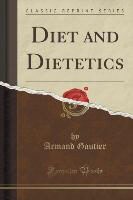Read more
Excerpt from Diet and Dietetics
Although this Second Edition appears only a few months after the First, it has been much modified and, we think, improved. Numerous new chapters and documents have been added to complete the work: we will only indicate among the additions, the table of the food supply in Paris during the decennial period 1890-1900, the developments relating to the establishment of the coefficients of intestinal utilization of foods; the experimental study of the requirements in energy of the man at rest or at work according to the last researches of Atwater; the description of the mechanism of general nutrition, of the action of assimilatory and dissimilatory ferments and of the origin of vital energy. In quite another category of ideas will be found in this volume numerous details which we had not yet given on toxic foods; the role of Salts in the system; on the rules which enable us to fix the rate and the nature of alimentation according to climates, weight and height of the subjects. As to the diet of invalids, the chapters relating to arthritis, liver complaints, nervous diseases, etc., are modified and completed. I have given (p. 519) a somewhat long note setting forth the new project of alimentation for hospital patients proposed by the Medical Society of the hospital physicians and surgeons of Paris, etc. Thus this Second Edition is increased by more than 130 new pages.
In striving to correct the imperfections and omissions of the First Edition I have endeavoured to respond to the confidence of those who have hoped to find in this work the solution of a number of questions upon which public health depends and which touch upon so many medical and sociological problems.
About the Publisher
Forgotten Books publishes hundreds of thousands of rare and classic books. Find more at www.forgottenbooks.com
This book is a reproduction of an important historical work. Forgotten Books uses state-of-the-art technology to digitally reconstruct the work, preserving the original format whilst repairing imperfections present in the aged copy. In rare cases, an imperfection in the original, such as a blemish or missing page, may be replicated in our edition. We do, however, repair the vast majority of imperfections successfully; any imperfections that remain are intentionally left to preserve the state of such historical works.

